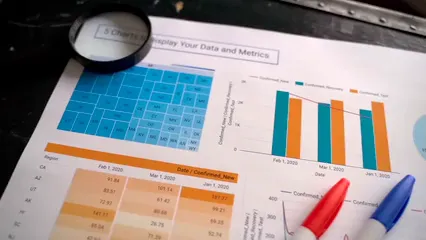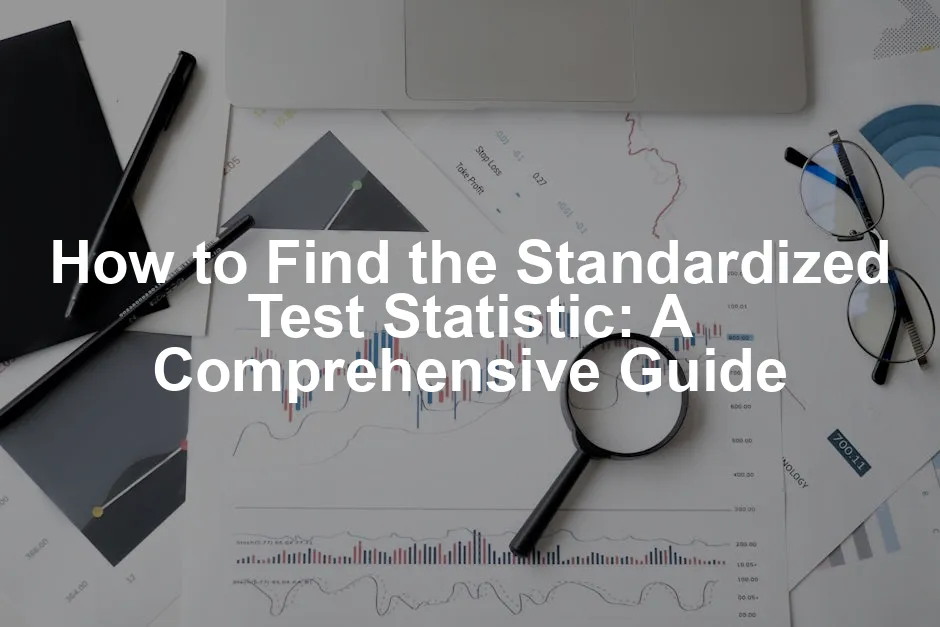Introduction
Standardized test statistics play a crucial role in hypothesis testing. They help researchers determine whether to reject the null hypothesis. Imagine you’re throwing a party and want to know if guests prefer pizza over burgers. A standardized test statistic tells you if the preference you observe is significant or just random chance.
There are several types of tests that utilize standardized test statistics. The most common are Z-tests and T-tests. A Z-test is often applied when sample sizes are large and the population standard deviation is known. On the other hand, T-tests are used for smaller samples or when the population standard deviation is unknown. Both tests provide a way to assess how far your sample statistic deviates from the hypothesized population parameter.
In this article, we’ll cover the ins and outs of finding standardized test statistics. You’ll learn how to define them, why they matter, and how to calculate them. By the end, you should feel confident in using these statistics to make informed decisions based on your data.

Understanding Standardized Test Statistics
What is a Standardized Test Statistic?
A standardized test statistic is a score that indicates how far a sample statistic deviates from the population parameter, expressed in terms of standard deviations. It allows comparison across different studies and tests, making it a powerful tool in hypothesis testing. Think of it as a way to transform your sample data into a format that can be easily analyzed.
In hypothesis testing, the standardized test statistic helps assess the likelihood of observing your sample data if the null hypothesis is true. For instance, if you’re comparing a sample mean to a population mean, the standardized test statistic tells you how extreme your sample mean is.
For example, let’s say you hypothesize that the average height of adult males in your town is 70 inches. You collect data and find that your sample average is 72 inches. The standardized test statistic will help you determine if this difference is significant or just a fluke.
And speaking of statistics, if you’re looking to dive deeper into the world of numbers, check out Statistics for Dummies. This book is like a friendly tour guide through the jungle of data!
Importance of Standardized Test Statistics
Standardized test statistics are essential for decision-making in research and statistics. They provide a common framework for comparing results from different tests. Whether you’re testing the effectiveness of a new drug or determining if a new teaching method improves student performance, these statistics help clarify your findings.
By using standardized test statistics, researchers can communicate results more effectively. They allow for comparisons across studies, even if the original data sets are different. This means you can look at various studies on similar topics and gauge their findings’ significance. In a nutshell, standardized test statistics simplify complex data, making it easier to draw meaningful conclusions.
In summary, understanding standardized test statistics equips you with the tools to evaluate hypotheses confidently. Whether you’re a student tackling statistics or a researcher analyzing data, mastering this concept is vital for sound decision-making.

Types of Standardized Test Statistics
Z-test
When to Use a Z-test
A Z-test comes into play when you have a large sample size—typically 30 or more. It requires that the population variance is known. If you were testing whether the average height of adult males in your town is significantly different from the national average, a Z-test is perfect.
For example, let’s say you have a sample of 100 adult males, and you want to test if their average height significantly differs from the national average of 70 inches. The sample size is adequate, and you know the population variance. Sounds like a Z-test situation!
Formula for Z-test
To calculate the Z-test statistic, you can use the following formula:
Z = \frac{\bar{x} - \mu}{\frac{\sigma}{\sqrt{n}}}
Where:
- \(\bar{x}\) is the sample mean,
- \(\mu\) is the population mean,
- \(\sigma\) is the population standard deviation, and
- n is the sample size.
Let’s work through an example. Suppose the sample mean height (\(\bar{x}\)) is 72 inches, the population mean (\(\mu\)) is 70 inches, the population standard deviation (\(\sigma\)) is 4 inches, and the sample size (\(n\)) is 100.
Plugging in the numbers, we get:
Z = \frac{72 - 70}{\frac{4}{\sqrt{100}}} = \frac{2}{0.4} = 5
Now, with a Z-score of 5, you can check Z-tables to see if this score is significant. Spoiler alert: it likely is!

T-test
When to Use a T-test
A T-test is your go-to when dealing with smaller samples, usually less than 30, or when the population variance is unknown. Imagine you’re curious about the average exam score of a small group of students—this is where a T-test shines.
For instance, if you have a sample of 15 students and want to know if their average score is significantly different from the class average of 75, a T-test is the way to go!
Formula for T-test
The formula for calculating the T-test statistic looks like this:
t = \frac{\bar{x} - \mu}{\frac{s}{\sqrt{n}}}
Where:
- \(\bar{x}\) is the sample mean,
- \(\mu\) is the population mean,
- s is the sample standard deviation, and
- n is the sample size.
Let’s work through a T-test example. Suppose your sample mean score (\(\bar{x}\)) is 78, the population mean score (\(\mu\)) is 75, the sample standard deviation (\(s\)) is 10, and the sample size (\(n\)) is 15.
Now, let’s compute:
t = \frac{78 - 75}{\frac{10}{\sqrt{15}}} \approx \frac{3}{2.58} \approx 1.16
With a T-score of approximately 1.16, you can then compare this value against critical T-values based on degrees of freedom to see if it’s significant. A T-test can reveal whether the students’ scores are truly higher than expected!
By understanding when to use Z-tests and T-tests, you’re well on your way to mastering standardized test statistics! These tests provide a robust framework for analyzing sample data against known population parameters, empowering you to make informed decisions based on statistical evidence.

Proportion Tests
One Proportion Z-test
A one proportion Z-test is your go-to tool when you want to compare an observed proportion to a theoretical one. This test is particularly useful when you’re dealing with a binary outcome, like whether someone found their real estate agent through a friend or not. So, if you’re investigating if more than half of home buyers find their agents this way, this is the test for you!
The formula for calculating the standardized test statistic in a one proportion Z-test is:
Z = \frac{\hat{p} - p_0}{\sqrt{\frac{p_0(1 - p_0)}{n}}}
Where:
- \(\hat{p}\) is the sample proportion,
- p_0 is the hypothesized population proportion,
- n is the sample size.
Let’s say you surveyed 1,000 home buyers and found that 457 of them found their agent through a friend. Here, your null hypothesis H0 is that p_0 = 0.50 (50% of buyers find their agents this way).
Calculating the sample proportion gives:
\hat{p} = \frac{457}{1000} = 0.457
Now, plug the numbers into the formula:
Z = \frac{0.457 - 0.50}{\sqrt{\frac{0.50 \times 0.50}{1000}}}
Calculating this yields:
Z = \frac{-0.043}{0.016} \approx -2.68
With a Z-score of -2.68, you can compare this against critical values to determine whether to reject the null hypothesis. Spoiler alert: you might just have some significant findings!

Two Proportion Z-test
When you want to compare two observed proportions, the two proportion Z-test is your best friend. It’s ideal when you have two groups and you want to see if their proportions are significantly different. Picture this: you’re examining whether the proportion of home buyers finding their agents through friends differs between two neighborhoods.
The formula for the two proportion Z-test is:
Z = \frac{\hat{p_1} - \hat{p_2}}{\sqrt{p(1 - p)\left(\frac{1}{n_1} + \frac{1}{n_2}\right)}}
Where:
- \(\hat{p_1}\) and \(\hat{p_2}\) are the sample proportions for the two groups,
- p is the pooled proportion,
- n_1 and n_2 are the sample sizes.
Let’s say you have two neighborhoods: Neighborhood A has 600 residents, and 300 found their agent through a friend. Neighborhood B has 400 residents, with 150 finding their agent this way.
First, calculate the sample proportions:
\hat{p_1} = \frac{300}{600} = 0.50, \quad \hat{p_2} = \frac{150}{400} = 0.375
Now, calculate the pooled proportion p:
p = \frac{300 + 150}{600 + 400} = \frac{450}{1000} = 0.45
Now, you can plug the values into the Z-test formula:
Z = \frac{0.50 - 0.375}{\sqrt{0.45(1 - 0.45)\left(\frac{1}{600} + \frac{1}{400}\right)}}
Calculating the denominator:
\sqrt{0.45 \times 0.55 \left(\frac{1}{600} + \frac{1}{400}\right)} \approx \sqrt{0.2475 \times 0.00375} \approx 0.096
Now, plug it all together:
Z \approx \frac{0.125}{0.096} \approx 1.30
With a Z-score of approximately 1.30, you can check against critical values to determine if the difference in proportions is statistically significant. And there you have it! Whether comparing one or two proportions, these tests unlock insights into your data like a magician revealing secrets!

Step 4: Compare with Critical Values
Once you’ve calculated your standardized test statistic, it’s time to put it to the test—literally! This involves comparing it against critical values derived from Z-tables or T-tables, depending on your test type. Think of these critical values as the bouncers at the club of statistical significance. If your test statistic makes it past them, you may just be on your way to rejecting the null hypothesis.
To find critical values, you first need to establish the significance level (alpha, α). Commonly set at 0.05, this level indicates a 5% risk of concluding that a difference exists when there is none. You can look up critical values in Z-tables or T-tables based on your alpha level. For instance, in a two-tailed test at a 0.05 significance level, you’d look for the critical values that correspond to the 2.5% tails on either side of the distribution.
Now, let’s chat about p-values. A p-value quantifies the probability of observing your results, or something more extreme, if the null hypothesis is true. Think of it as the ultimate gauge of how much the data likes to play hard to get. If your p-value is less than or equal to your alpha level, it’s a sign that your standardized test statistic is indeed significant. In other words, it’s got the moves to reject the null hypothesis!

Step 5: Make a Decision
With your standardized test statistic in hand and a comparison against critical values and p-values, you’re ready to make an informed decision. The first step is interpreting your results. If your test statistic exceeds the critical value or your p-value is less than your alpha, you can confidently reject the null hypothesis. This is like telling the universe, “Yes, my sample data is significant enough to warrant a change in belief!”
However, if your test statistic doesn’t surpass the critical value or your p-value is above your alpha, you fail to reject the null hypothesis. This doesn’t mean your hypothesis is proven; rather, it suggests that there’s insufficient evidence to dismiss it. It’s akin to saying, “Well, maybe the universe isn’t ready for that change just yet.”
Understanding the implications of these decisions is crucial. Rejecting the null hypothesis can lead to new insights, further research, or even policy changes, while failing to reject it might indicate that your hypothesis isn’t supported, thus steering your next steps in research or analysis. So, choose wisely—your data is counting on you!

Example 3: Proportion Test
Let’s say you’re a real estate analyst with a burning question: Do home buyers find their agents through friends more than half the time? You decide to run a survey, and here’s what you discover: Out of 1,000 home buyers, 457 found their agent through a friend. Cue the suspenseful music!
First, you’ll state your hypotheses. Your null hypothesis (H0) is that the true proportion of home buyers who find their agents through friends is 0.50. The alternative hypothesis (Ha) is that it’s not 0.50. Mathematically, that looks like this:
- H0: p = 0.50
- Ha: p ≠ 0.50
Now, it’s time to calculate the standardized test statistic using the one proportion Z-test formula:
Z = \frac{\hat{p} - p_0}{\sqrt{\frac{p_0(1 - p_0)}{n}}}
Where:
- \hat{p} is the sample proportion,
- p_0 is the hypothesized population proportion,
- n is the sample size.
Plugging in the numbers, we first calculate \(\hat{p}\):
\hat{p} = \frac{457}{1000} = 0.457
Now let’s substitute these values into the formula. Here, p_0 = 0.50 and n = 1000:
Z = \frac{0.457 - 0.50}{\sqrt{\frac{0.50 \times 0.50}{1000}}}
Now, calculating the denominator:
\sqrt{\frac{0.50 \times 0.50}{1000}} = \sqrt{\frac{0.25}{1000}} \approx 0.01581
Now, back to the Z formula:
Z = \frac{-0.043}{0.01581} \approx -2.72
With a Z-score of approximately -2.72, it’s time to check the Z-tables or calculate the p-value. If your p-value is less than your significance level (say, 0.05), it’s time to reject the null hypothesis. This would suggest that fewer than 50% of home buyers find their agents through friends, leading to some interesting conclusions for your real estate strategies!
In conclusion, using survey data to calculate a standardized test statistic for proportions is straightforward and can yield significant insights. So, the next time you have data, don’t forget to test those proportions!

Conclusion
Standardized test statistics are your trusty sidekicks in the world of hypothesis testing. They help you navigate through your data jungle, determining whether your findings are statistically significant or just a product of random chance. Throughout this article, we’ve journeyed through various tests, including Z-tests and T-tests, focusing on how to find the standardized test statistic.
Key takeaways include understanding when to use different tests based on sample size and variance knowledge. Z-tests are typically reserved for larger samples with known population variances, while T-tests are perfect for smaller samples or unknown variances. Proportion tests allow you to compare observed data against theoretical expectations, providing a rich landscape for analysis.
The importance of these statistics cannot be overstated. They empower researchers and decision-makers alike to draw conclusions from data, making informed choices that can impact real-world scenarios. Whether you’re analyzing survey responses or experimental results, a solid grasp of standardized test statistics will enhance your analytical skills. For more on hypothesis testing, check out this statistics hypothesis testing cheat sheet.
Understanding hypothesis testing is essential for making informed decisions based on statistical evidence. Explore the comprehensive guide on hypothesis testing.
Now that you’re equipped with the knowledge of standardized test statistics, it’s time to put theory into practice. I encourage you to seek out real data—perhaps from surveys, experiments, or even your own experiences—and calculate standardized test statistics. The more you practice, the more confident you’ll become. Your newfound skills will not only help you ace that statistics exam but also provide valuable insights that could influence your career or personal projects.
Remember, the world of data is ever-evolving, and your ability to analyze it will set you apart. So go forth, crunch those numbers, and make statistics your ally! And if you need a handy reference, consider picking up The Art of Statistics: Learning from Data—it’s like having a statistical buddy!
FAQs
What is the difference between a Z-test and a T-test?
The main difference between Z-tests and T-tests lies in the sample size and the knowledge of population variance. Z-tests are used when sample sizes are large (typically 30 or more) and the population standard deviation is known. Conversely, T-tests are employed for smaller samples (less than 30) or when the population standard deviation is unknown. Thus, the choice between these tests is crucial depending on your data characteristics.
How do I calculate a standardized test statistic?
Calculating a standardized test statistic involves a few straightforward steps. First, state your null and alternative hypotheses. Next, determine the appropriate test based on your data. For a Z-test or T-test, use the relevant formula: For Z-test: Z = (x̄ – μ) / (σ / √n) For T-test: t = (x̄ – μ) / (s / √n) Finally, substitute your values into the formula to compute the statistic, and compare it against critical values or p-values to make your decision.
When should I use a one-tailed vs. two-tailed test?
A one-tailed test is appropriate when you have a specific direction in mind (e.g., testing if a mean is greater than a certain value). A two-tailed test is used when you’re checking for any significant difference, regardless of direction (e.g., testing if a mean is different from a certain value). Choose based on your hypothesis and research question.
What is a critical value?
A critical value is a threshold that you compare your standardized test statistic against to decide whether to reject the null hypothesis. It’s derived from the statistical distribution you’re working with (Z or T). If your test statistic exceeds this critical value, it suggests that your results are statistically significant.
Can I use software to calculate standardized test statistics?
Absolutely! Many statistical software programs, such as R, Python, SPSS, and even Excel, can perform calculations for standardized test statistics efficiently. They simplify the process and allow for quick analysis of complex datasets, making your statistical journey smoother and more efficient.
Please let us know what you think about our content by leaving a comment down below!
Thank you for reading till here 🙂
If you’re interested in expanding your statistical knowledge further, consider reading Statistical Methods for the Social Sciences. It’s a great resource for understanding how to apply statistics in real-world contexts!
Another must-have is Graphing Calculator (Texas Instruments TI-84 Plus). This handy tool can simplify your calculations and help you visualize data effectively!
For those who want to take their data analysis to the next level, consider Minitab Statistical Software. It’s a powerful tool used in many industries for data analysis!
For anyone looking to master Excel, Excel for Dummies is an excellent guide to help you get started!
Lastly, if you’re venturing into data science, I highly recommend The Data Science Handbook. It offers valuable insights and methodologies that can enhance your analytical skills!
All images from Pexels




